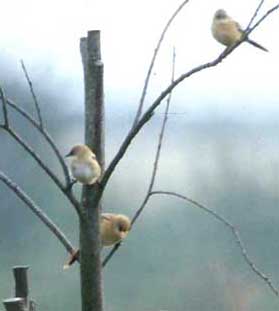
a web page by Don Roberson |
REEDLING Panuridae |
|
Traditionally, Bearded Reedling has been considered a part of the Parrotbill assemblage, and that family was often known as the Panuridae, since it was the earliest of the family to be formally named. The rest of the 'family' was composed of 18 species of Paradoxornis parrotbills and Great Parrotbill Constomas oemodium. Indeed, the Handbook of the Birds of the World series (Vol. 12, due out in fall 2007) will have a Parrotbill 'family' known as the Paradoxornithidae. I am not sure where they will place Panurus — possibly in the Babblers. It is clear, however, that even the HBW 'family' will last only temporarily. They presumably have retained it for traditional purposes pending more research. |
| The problem is that recent biochemical evidence (Alström et al. 2006, Jønsson & Fjeldså 2006, Barker et al. 2004, Cibois 2003) has found that the Paradoxornis parrotbills are "embedded" within the Babblers. The evidence also suggests that the Babblers may be a huge assemblage that might constitute two or more clades, and that some birds traditionally considered Old World Warblers are, in fact, babblers (particularly those in the genus Sylvia). The preliminary DNA evidence suggests Panurus is an early offshoot of the Old World Warbler group. Whether it deserves family rank is not yet known. I do so here provisionally, because it 'must' appear somewhere for world birding purposes. It is possible that further research may show that the reedling is actually closer to the other parrotbills than this assignment might suggest (see Alström et al. 2006, Jønsson & Fjeldså 2006). |
The reedling is a highly gregarious species outside the breeding season. Youngster form flocks after they gain independence and these flocks increase in size as they are joined by adults after the nesting season. Flocks can grow to 200 birds. These flocks break up in spring as nesting territories are formed. Birds in flocks are quite vocal but as nesting season takes over, birds are quieter and become inconspicuous (Cramp & Perrins 1993). John Marchant took this shot of a part of a flock in Norfolk, England (right). Populations here have been studied extensively. Populations are much less known across eastern eastern Russian and northern China. |
Photos: W. Ed Harper photographed the banded Bearded Reedling Panurus biarmicus in southern England in May 2000. John Marchant photographed the group of reedling at Titchwell, Norfolk, England, on 20 July 1980. All text © 2007 Don Roberson; photos © 2007 W. Ed Harper or John Marchant, as attributed (used with permission); all rights reserved. Bibliographic note: There is no "family book" per se; I assume this species will be covered by the next volume in the HBW series. Literature cited:
|
 Elevating the Bearded Reedling Panurus biarmicus
to family level status is preliminary and tentative. This passerine of
reedy marshes is patchily distributed across the Palearctic from
England to China. They live in small flocks and are probably best known
from a few local marshes in southern or eastern England (left in an
individual portrait of a banded bird © W. Ed Harper) where it is
known as the "Bearded Tit."
Elevating the Bearded Reedling Panurus biarmicus
to family level status is preliminary and tentative. This passerine of
reedy marshes is patchily distributed across the Palearctic from
England to China. They live in small flocks and are probably best known
from a few local marshes in southern or eastern England (left in an
individual portrait of a banded bird © W. Ed Harper) where it is
known as the "Bearded Tit." Whatever
its final taxonomic resting place, Bearded Reedling is an interesting
species. It is patchily distributed in the western Palearctic. In
Britain, for example, it occupies less than 1% of available habitat
(Cramp & Perrins 1993). It prefers large tracts of Phragmites
reeds in fresh or brackish marshes. Populations are primarily resident,
but the breeding range has expanded in good climates and retracted
after harsh winters.
Whatever
its final taxonomic resting place, Bearded Reedling is an interesting
species. It is patchily distributed in the western Palearctic. In
Britain, for example, it occupies less than 1% of available habitat
(Cramp & Perrins 1993). It prefers large tracts of Phragmites
reeds in fresh or brackish marshes. Populations are primarily resident,
but the breeding range has expanded in good climates and retracted
after harsh winters.